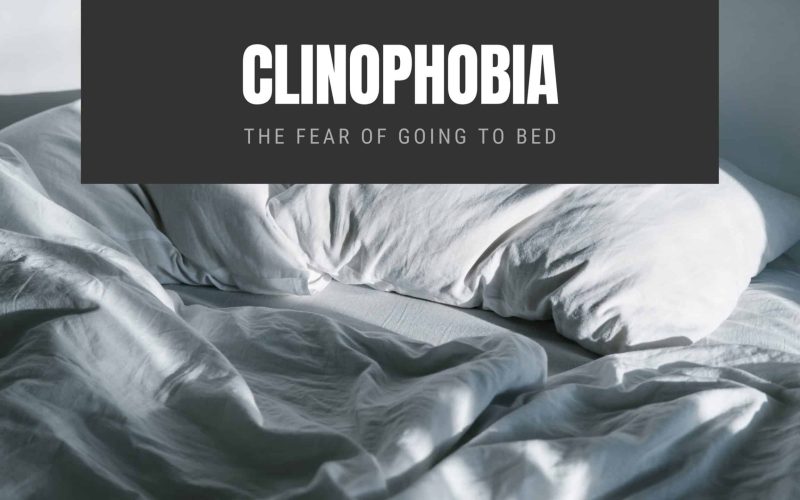Fear of going to bed is also known as clinophobia. This causes intense fear and anxiety, especially at the thought of going to bed.
This phobia is also known as somniphobia, hypnophobia, sleep anxiety, or sleep dread.
Sleep is a natural phenomenon where your body and mind rest periodically while active consciousness is ceased.
Good sleep is essential for having good health. Good sleep can be refreshing, sweet, and rejuvenating.
Unfortunately, some people are deprived of enjoying sleep due to sleep disorders and phobias. This fear may be ridiculous to some people except for the sufferer.
However, sufferers often realize that the fear they feel is irrational, yet they cannot help it.
Therefore, they prefer to avoid it. This can hinder their normal way of life and affect their relationships with their environment and others. Therapy can help a sufferer of this condition to recover.
Causes of Fear of Going to Bed
Experts are not sure about the exact cause of this condition. However, they believe that certain factors contribute to the development of this fear, and these factors may include:
Genetics
Genes are traits passed down from parents to offspring. These traits help make up some physical, social, and mental characteristics.
However, experts believe that as these traits are passed down, fearful genes can also be passed on. Therefore, a sufferer of this condition is likely to bear children who will suffer this as well.
Upbringing
Persons who grew up with people (neighbors or family members) who have this condition are likely to suffer from this phobia as well.
Also, individuals who scare children about their nightmares, sleep paralysis, or even darkness can make those children have this condition. Therefore, a child’s fear of going to bed must be addressed instead of abuse.
Past Experience
Past experiences, such as stories associated with the dangers of going to bed, may influence clinophobia.
For instance, many children are made to believe that monsters are under their beds while they are asleep.
Such stories can make a child fear going to bed. Some of them may fail to outgrow this fear.
Also, unpleasant past events such as surviving a fire outbreak or sexual assault can make someone fear going to bed.
Sleep Disorders
A sleep disorder can be defined as the changes in the normal sleeping pattern of an individual that are detrimental to the health and well-being of an individual.
There are various sleeping disorders known, but the following are the ones believed to contribute to the development of fear of going to bed:
Sleep Paralysis
This a sleep disorder that most people dread because of how realistic it appears. Each episode of sleep paralysis is an experience of scary hallucinations that is more like a real-life nightmare than a mere nightmare.
This sleep disorder occurs when you are awake from REM sleep but cannot move because your muscles are paralyzed.
Fearful attacks characterize most sleep disorders, but it is only mere hallucinations. This makes it very unpleasant and scary, and when it becomes recurrent and frequent, you may develop a fear of going to sleep.
Nightmare Disorder
Nightmare disorder may result from having persistent nightmares that seem so realistic. Most times, you find yourself so absorbed in the previous nightmare episode that you are terrified to have them again.
This can disrupt and ruin your day. When this nightmare disorder becomes so persistent that you expect it as soon as you close your eyes, then you are most likely to develop this condition.
However, there are other factors which are believed to cause this condition:
- Experiencing repeated episodes of Post-traumatic Stress Disorder (PTSD) about a traumatic event that must have happened in the past can cause nightmare disorders, as well as clinophobia.
- The fear of awful events that can occur at night can cause an individual to worry and be afraid to sleep. When this becomes frequent, then clinophobia is likely to occur. These awful events may include rape, burglary, fire outbreak, and other worrisome incidents.
- For some reason, some people are afraid that they could die in their sleep. This could be because they know someone who died like that or that they are sick. It becomes a major issue when such thoughts and beliefs are not dealt with.
There are possibilities that an individual can develop the fear of going to bed without any precise reason. Or maybe the person cannot remember when and why he or she has clinophobia.
Symptoms of Fear of Going to Bed
Sufferers do not necessarily need to be in a condition where they have to go to experience the symptoms of this phobia.
Sometimes, the sufferer’s brain is capable of making you feel intense fear and anxiety even when the individual is not in the face of danger.
The person would feel threatened, and this triggers some symptoms. Most times, these symptoms may occur suddenly and without any prior signs.
The physical symptoms of fear of going to bed may include the following:
- Sweating
- Trembling
- Hot flushes or chills
- Shortness of breath or difficulty breathing
- A choking sensation
- Rapid heartbeat (tachycardia)
- Pain or tightness in the chest
- A feeling of butterflies in the stomach
- Nausea
- Headaches and dizziness
- Feeling faint
- Numbness or pins and needles
- Dry mouth
- A need to go to the toilet
- Ringing in your ears
- Confusion or disorientation
- Hyperventilation
- Tightness in the chest or chest pain and difficulty breathing
- A rise in blood pressure
The psychological symptoms of fear of going to bed may include the following:
- Fear of fainting
- Feelings of dread
- Fear of dying
- Fear of harm or illness
- Guilt, shame, self-blame
- Fear of losing control
- Withdrawing from others
- Feeling sad or hopeless
- Feeling disconnected
- Confusion, difficulty concentrating
- Anger, irritability, and mood swings
- Anxiety and fear
In rare cases, people develop intertwined phobias, also known as “complex phobias.” This is when a person has more than one phobia.
Once one is triggered, he or she experiences a chain of symptoms associated with the phobias, including depression.
This can be highly detrimental to a person’s health and mental well-being.
Treatment of Fear of Going to Bed
Many sufferers do not seek medical attention because they feel that they can avoid sleep, but no one can avoid sleep for life.
Also, severe and persistent fear of going to bed can limit the sufferer’s life and hinder his or her relationships.
Therefore, getting treatment as soon as possible is necessary. However, experts believe that no treatment for phobias is guaranteed to work, but most people who received treatment learned to cope better even in the face of their fears.
The treatment involves contacting a mental health worker. A mental health worker is a trained health worker equipped with the necessary knowledge and skills to help you with the challenges in your mental health.
The knowledge and skills that these professionals possess include various techniques that can be applied to help you with your phobias.
The following are the techniques used in treating clinophobia:
Self-care
Taking good care of yourself can manage mild and moderate cases of fear of going to bed. This will make you feel in charge of yourself and your well-being, and with that, you can control your fear of going to bed.
The following are tips that can help:
- Meditation: Daily meditation helps to get your mind channeled away from the negative to the positive thinking patterns
- Proper dieting: Eating healthy meals helps keep your body and mind healthy
- Exercising: Exercising is a great way to keep your body fit and your mind focused. Taking a walk or exercising can help you shift your thoughts from unhealthy to healthy ones.
Counseling
Counseling is a one-on-one talk with your psychotherapist. This mindful chat with a non-judgmental person, in a cool and controlled environment, can help you a great deal.
In the course of the discussion, your therapists will help you identify those unhealthy thinking and belief patterns that may be affecting you.
He or she may assure you that there is nothing to fear. Your therapist may equip you with coping strategies to help you control or overcome your fears.
Exposure therapy
This may be defined as the gradual exposure of a patient to his or her object of fear under professional supervision to reduce sensitivity to it. This technique is also known as systematic desensitization.
The therapist sets up stages of exposure, and the patient has to pass the first stage before getting to the second stage and progressively until the last stage.
Within a controlled environment, your therapist may start with a simple discussion about going to bed, and if you show less or no sensitivity to it, you progress to to the next stage.
The next stage may be a picture of a bed; then, you may be allowed to apply some coping strategies to pass that stage successfully.
The bottom line of this technique is that the more exposed you are, the less threatened you feel about your source of fear.
It teaches patients how to regain control of themselves, even in the face of their fears. They also help give you a healthy sleeping pattern so you will feel less threatened about going to bed.
Hypnotherapy
Hypnotherapy is the process of opening up the subconscious mind to reprogram and correct negative thinking and belief patterns that cause you to fear going to bed. A professional should strictly do this.
Use of Medications
Seeing a therapist is almost enough to help you recover from this condition. However, drugs are prescribed to help suppress anxiety and other symptoms of phobias. However, administering medicines is not a cure for phobias.
The medication may include:
- Anti-anxiety drugs: This type of drug is administered to reduce anxiety. Valium is an excellent example of anti-anxiety
- Anti-depressant drugs: This type of medication is prescribed because it can lower stress, and Lexapro is a typical anti-depressant
Note: These medications are likely to have several side effects, and long-term usage can cause Substance Abuse Disorder (SAD). Therefore, these drugs should not be taken without a licensed doctor’s prescription.








